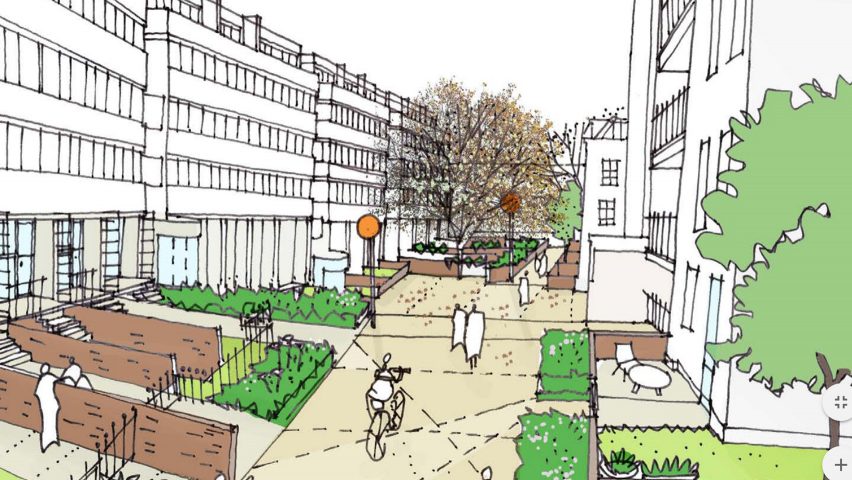Architects including Adjaye Associates have presented ideas for the refurbishment of the Lancaster West Estate in London, site of the Grenfell Tower tragedy.
Cullinan Studio, Maccreanor Lavington, Murray John Architects, Levitt Bernstein and Penoyre & Prasad also contributed concepts to the report produced by Lancaster West Residents Association, exploring the future of the estate.
The report doesn't include Grenfell Tower, which was destroyed by fire on 14 June 2017. But it does contains a book of ideas for each of the estate's blocks, along with a overarching report that looks at improving the public walkways and communal areas.
The solutions suggested by architects were informed by a series of workshops and ideas days, where residents of the estate were invited to raise problems and suggest potential improvements.
"These books are the next steps in our work with architects and the council to design the future of the estate," said the Lancaster West Residents Association in the report.
"This work gives us a major voice on the future of our own homes. After the tragedy last June, this is fundamental step for residents to begin the process of rebuilding their lives."
A report leaked earlier this month concluded that "deficiencies" introduced during renovation work fuelled the deadly Grenfell Tower fire, which killed 71 people. The tower and the area immediately around it will remain a crime scene until the summer, as the police investigation continues.
Of the £28 million promised by the British government to aide the recovery effort, £15 million has been set aside for the regeneration of the wider estate, which was built in the 1970s and is home to 1,000 households.
Kensington and Chelsea council has promised a resident-led project, with no demolition of people's homes and residents' ideas for improvements taken into account. The council had previously faced criticism for ignoring concerns by Grenfell Tower residents that refurbishment work had made it unsafe.
Issues to address in the refurbishment project, as identified in the report, include poor accessibility and layout in individual flats, as well as problems with ventilation and damp.
Wider issues affecting the estate as a whole are also identified. These include flooding in the streets, a deficit of safety and security measures across the estate, and a lack of green spaces.
The architects responded with concepts tailored to specific parts of the estate, which has been separated into nine areas for the purpose of the refurbishment.
A proposal for re-landscaping of a pedestrianised street for Camelford Court includes raised flowerbeds and benches that could give ground floor flats privacy and produce a more pleasant environment. Another suggestion is for a small pavilion set in the green space surrounded by Talbot Grove House that could provide extra community facilities.
Ideas mooted for redesigning the entrances to some of the blocks suggested removing dark corners by opening them up to the street, adding private gardens to some of the flats and adding key-fob secured gates. In the interim, the report suggested adding CCTV and extra lighting to heighten security before major works go ahead.
Internally, the layout of the flats could be re-worked to introduce open-plan living and dining areas, as well installing new kitchens and bathrooms, and general redecorating.
Double-glazed windows would help with the damp and ventilation problems, although the report admitted that bigger problems with leaking pipes would be harder to fix. Overcrowding is also listed as an issue, although the architects suggest that extensions could be made at rooftop and basement level.
In the next part of the process, residents will be asked to select which designers they want to carry out the proposed plans.
Images sourced from Book of Ideas via Lancaster West Residents Association.

